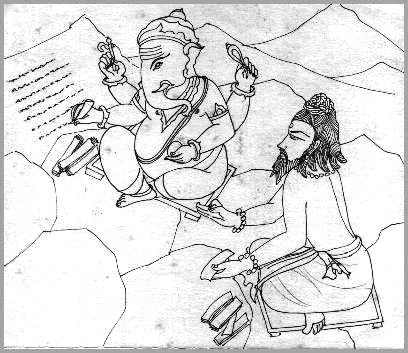Snippets of Information
THE EPIC MAHABARATHAM
* Jul 2021
This work is a tree, of which the chapter of contents is the seed ; the
divisions called Pauloma and Astika are the root ; the part called
Sambhava is the trunk ; the books called Sabha and Aranya are the
roosting perches ; the books called Arani is the knitting knots ; the
books called Virata and Udyoga the pith ; the book named Bhishma, the
main branch ; the book called Drona, the leaves ; the book called Kama,
the fair flowers ; the book named Salya, their sweet smell ; the books
entitled Stri and Aishika, the refreshing shade ; the book called Santi,
the mighty fruit ; the book called Asiuamedha, the immortal sap ; the
denominated Asramavasika, the spot where it groweth ; and the book
called Mausala, is an epitome of the Vedas and held in great respect by
the vrituous Brahmanas. The tree of the Bharata, inexhaustible to
mankind as the clouds, shall be as a source of livelihood to all
distinguished poets.'
- Vol 1, Adi Parva
* Jul 2021
In the Mahabaratha war
Bhishma fought for ten days.
Drona for five days.
Kama fought for two days
Salya for half a day.
* Jul 2021
Sauti, son of Suta explains to the rishis, the number of horse, foot, chariots and elephants, which compose an Akshauhini
One chariot, one elephant, five foot-soldiers, and three horses form - one Patti
three pattis make one Sena-mukha
three sena-mukhas forms a Gulma
three gulmas forms a Gana
three ganas forms a Vahini
three vahinis together forms a Pritana
three pritanas forms a Chamu
three chamus forms an Anikini
an anikini taken ten times forms an Akshauhini.
the number of chariots in an Akshauhini is twenty-one thousand eight hundred and seventy.
the number of elephants in an Akshauhini is twenty-one thousand eight hundred and seventy.
the number of foot-soldiers is one hundred and nine thousand three hundred and fifty
the number of horses is sixty-five thousand, six hundred and ten.
* Jul 2021
Sage Vyaasa is siad to have rendered a total of 60 lakhs slokas.
The epic, as is available to us now consists of 18 sections (parvas)
with 98 sub sections (sub parvas), 2,382 chapters with 96,635 verses.
The 18 sections have been classified under four classifications - Aadhya
Panchakam (5 sections), Yudhdha Panchakam (5 sections), Shaanthi thryam
(3 sections), Andhya Panchakam (5 sections). Each of the sections
such as the Aadi parvam have several sub sections within.
Aadhya Panchakam
1. Aadi parvam (260 sub sections - 10,889 slokams)
2. Sabha parvam (173 sub sections - 4,367 slokams)
3. Vana parvam (315 sub sections - 12,476 slokams)
4. Viraada parvam (78 sub sections - 3,494 slokams)
5. Udhyoga parvam (196 sub sections - 6,753 slokams)
Yudhdha Panchakam
6. Bhishma parvam (122 sub sections - 5,809 slokams)
7. Drona parvam (203 sub sections - 10,012 slokams)
8. Karna parvam (101 sub sections - 4,975 slokams)
9. Shalya parvam (66 sub sections - 3,596 slokams)
10. Sauptika parvam (17 sub sections - 815 slokams)
Shaanthi thryam
11. Stree parvam (28 sub sections - 807 slokams)
12. Shanti parvam (375 sub sections - 15,151 slokams)
13. Anusaasana parvam (272 sub sections - 11,194 slokams)
Andhya Panchakam
14. Asvamedha parvam (118 sub sections - 4,555 slokams)
15. Aashramavaasika parvam (41 sub sections - 1,098 slokams)
16. Mausala parvam (9 sub sections - 301 slokams)
17. Mahaaprasthaanika parvam (3 sub sections - 111 slokams)
18. Swargaarohana parvam (5 sub sections - 232 slokams)
* Jul 2021
Sage Vyaasa, who classified the Vedas into four parts, is the author of
the epic Mahabaratham. Lord Ganesha put the slokas in writing as sage
Vyaasar narrated it. Vyaasar first taught his son, sage Sukar
(Suka) and several other other disciples, thus ensuring the epic tale
was not lost to the future generations.
It is believed that sage Narada told the epic to the Devas, Sage Suka
taught Mahabaratham to the Gandharvas, Rakshasas and Yakshaas and
Vaisampaayana, a chief disciple of sage Vyaasa told the Bhaaratham to
mankind. He narrated the epic sotry during a yagna performed by
king Janamejayan, son of king Pareekshit. Pareekshit was the son of
Abhimanyu and Uttarai, the grandson of Arjuna and Subathra.
This Bharatham narrated by Vaisampaayanar was later told by Sudar to
several rishis led by rishi Sounagar in the Naimisaaranyam forest.
Sage Vyaasa is siad to have rendered a total of 60 lakhs slokas.
The epic, as is available to us now consists of 18 sections (parvas)
with 98 sub sections (sub parvas), 2,382 chapters with 96,635 verses.
The 18 sections have been classified under four classifications - Aadhya
Panchakam (5 sections), Yudhdha Panchakam (5 sections), Shaanthi thryam
(3 sections), Andhya Panchakam (5 sections). Each of the sections
such as the Aadi parvam have several sub sections within.
* Jul 2021
Maha Bharatham
Maha rishi Veda (Vedha) Vyaasar saw the entire Mahaa Bharatham through
his inner vision. He wanted to preserve it for the welfare of the future
generations. Lord Brahma advised him to ask Lord Ganesha to write it
down as he composed the verses. Lord Ganesha is said to have used his
tusk to write the Maha Bharatham on the Himalayas.
It comprises of 18 parvas (parvam) - Adi parvam, Sabha parvam, Vana
parvam, Virata parvam, Udyoga parvam, Bhishma parvam, Drona parvam,
Karna parvam, Shalya parvam, Sauptika parvam, Stri parvam, Shanti
parvam, Anushasana parvam, Asvamedhika parvam, Ashramavasika parvam,
Mausala parvam, Mahaprasthanika parvam, Swargarohana parvam.
Harivamsa parvam dealing with the life of Lord Krishna is not covered in the 18 parvams of Mahabharatham.
These 18 parvams contain 98 sub parvams of 2,382 chapters. There are a
total of 96,635 slokas that are available now. Vyasar is said to have
composed 60 lakh shlokams.

Read the story - Vinayagar wrote the Bharatham
|